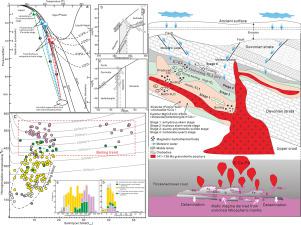Journal of Geochemical Exploration ( IF 3.9 ) Pub Date : 2021-07-27 , DOI: 10.1016/j.gexplo.2021.106862 Xiao Xiong 1 , Laimin Zhu 1 , Guowei Zhang 1 , Jun Zheng 1 , Hang Jiang 1

|
Traditional metallogenic models posit that porphyry–skarn Cu systems form in subduction and collision zones. However, in eastern China, many important Late Mesozoic porphyry–skarn deposits have formed in intracontinental settings related to lithospheric break-up during the celebrated tectonothermal, Yanshanian event. The Xiaohekou Cu skarn deposit in the southern Qinling Orogen presents an ideal case study to describe such ore deposit geology, using mineral and fluid inclusion analysis, in addition to sulfide and granitoid S Pb isotope studies. A detailed metallogenic process model for the intracontinental skarn Cu deposit is proposed.
Pb isotope studies. A detailed metallogenic process model for the intracontinental skarn Cu deposit is proposed.
The authors recognize four main paragenetic stages: (I) anhydrous skarn, (II) hydrous skarn–Fe oxide, (III) quartz–polymetallic sulfide, and (IV) carbonate–quartz. Stage I is characterized by high temperatures (346–547 °C), high to moderate salinities (6.74–49.2 wt% NaCleqv), together with acidic and oxidizing H2O-NaCl fluids. From early to late anhydrous skarn stage, un-zoned grossular (Adr24–31Gr68–74), a grossular–andradite alternation series with wide zones (Adr26–68Gr31–72) and diopside (Di73–91Hd8–24)–pure andradite with dense oscillation zones (Adr68–100Gr0–30) crystallized sequentially, representing a gradual shift toward higher fO2 conditions. Diopside-hosted fluid inclusions (FIs) contain halite-bearing three phase (H-type), liquid-rich two-phase (L-type), and vapor-rich two-phase (V-type) inclusions, suggesting such fluids were sourced from a silicate melt and stage I & II boiling of magmatic-hydrothermal fluids at lithostatic depths of 1.1–3.3 km.. The FIs in actinolite (stage II) are characterized by homogenization temperatures (Th) of 273–502 °C and salinities of 4.34–42.8 wt% NaCleqv. Cooling and dilution of the ore-forming hydrothermal fluid, as well as the high fO2 conditions were responsible for the hydrous skarn alteration in addition to magnetite and specularite deposition. Stage III constitutes the principal Cu mineralizing event. Quartz from this stage contains distinctive liquid-rich inclusions, with Th of 143–423 °C and salinity of 2.07–17.8 wt% NaCleqv. Their Th values include two populations (210–270 °C and 303–359 °C) suggesting a commingling of hot magmatic-hydrothermal fluid and meteoric water accompanied by a significant fO2 decrease and pH increase was a principal factor behind chalcopyrite-pyrite-pyrrhotite deposition. The fluids in stage IV (81–218 °C and 0.18–14.1 wt% NaCleqv) are likely be the chilled equivalent of fluid from the Cu mineralization stage which equilibrated with marble. S Pb isotopes reveal that the metals were derived from the granitic rocks and produced by hybrid (mantle+crust)-derived magmas. We propose hydrothermal fluids exsolved from the cooling granitic magma contributed the majority ore-forming materials. Whereas ore-forming fluids clearly interacted with country rocks affecting ore precipitation, skarn development and deposit geometry and emplacement. Devonian host rocks donated little if any of either sulfur or base metals to the mineralization process.
Pb isotopes reveal that the metals were derived from the granitic rocks and produced by hybrid (mantle+crust)-derived magmas. We propose hydrothermal fluids exsolved from the cooling granitic magma contributed the majority ore-forming materials. Whereas ore-forming fluids clearly interacted with country rocks affecting ore precipitation, skarn development and deposit geometry and emplacement. Devonian host rocks donated little if any of either sulfur or base metals to the mineralization process.



























 京公网安备 11010802027423号
京公网安备 11010802027423号